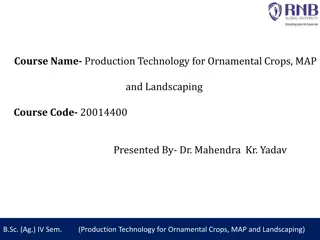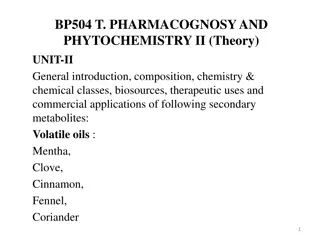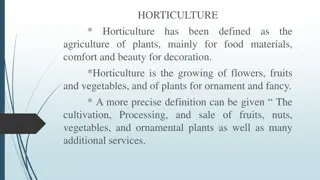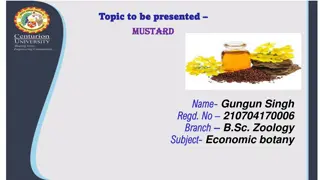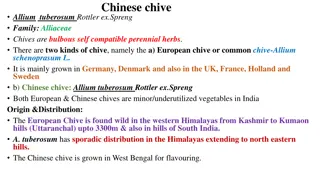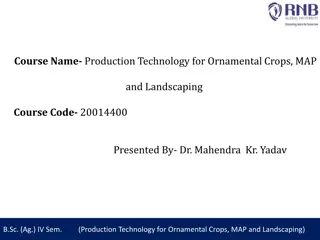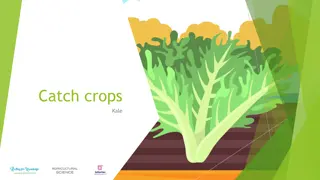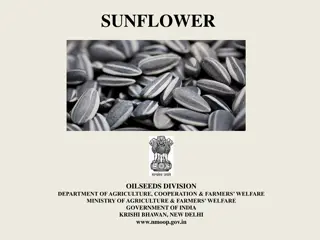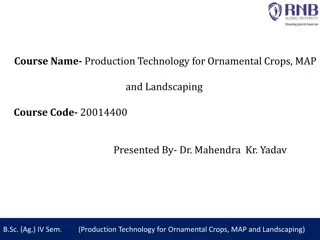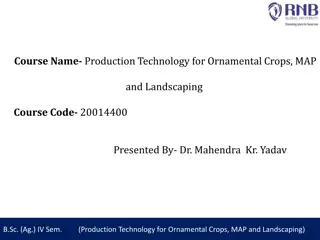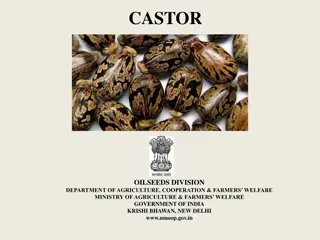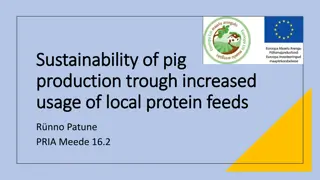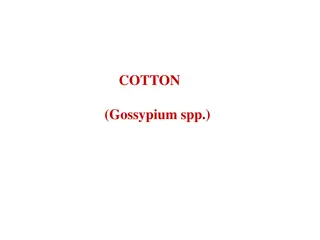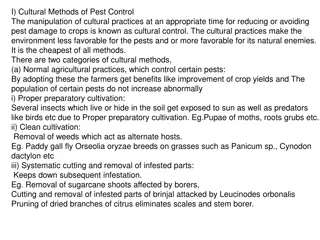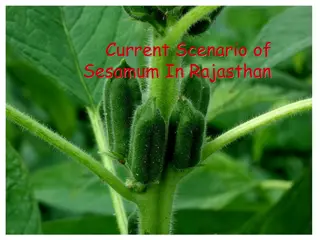Rapeseed and Mustard: Overview of Production and Cultivation
The Rapeseed and Mustard Oilseeds Division of the Department of Agriculture in India focuses on the production and cultivation of Brassica juncea, with India holding a prominent position in both area and production. These crops thrive in tropical and temperate zones, with specific climate and soil requirements. Varieties such as toria, brown sarson, and yellow sarson play key roles in India's agriculture, with Indian mustard being a major cultivar. The global and national scenarios of rapeseed and mustard production are also highlighted.
Uploaded on Oct 08, 2024 | 3 Views
Download Presentation

Please find below an Image/Link to download the presentation.
The content on the website is provided AS IS for your information and personal use only. It may not be sold, licensed, or shared on other websites without obtaining consent from the author.If you encounter any issues during the download, it is possible that the publisher has removed the file from their server.
You are allowed to download the files provided on this website for personal or commercial use, subject to the condition that they are used lawfully. All files are the property of their respective owners.
The content on the website is provided AS IS for your information and personal use only. It may not be sold, licensed, or shared on other websites without obtaining consent from the author.
E N D
Presentation Transcript
RAPESEED AND MUSTARD OILSEEDS DIVISION DEPARTMENT OF AGRICULTURE, COOPERATION & FARMERS WELFARE MINISTRY OF AGRICULTURE & FARMERS WELFARE GOVERNMENT OF INDIA KRISHI BHAWAN, NEW DELHI www.nmoop.gov.in
BOTANICAL DESCRIPTION Family : Cruciferae Common Name : Mohari, Tikkya, Serson Scientific Name : Brassica juncea Origin : Europe India occupies the first position both in area and production of rape seed and mustard
SEASON AND CLIMATE The crops are of the tropical as well as temperate zones and require relatively cool temperature. Mustard could be successfully grown under wide range of soils including saline/alkaline, low irrigated and paddy fallows in Eastern India. An average day and night temperature of 250 C is considered optimum. From August end to first half of September is best for sowing of toria, 25th September to 15th October for sarson, 30th September to 15th October for mustard. Soil and climate The rapeseed and mustard thrive well on light to heavy loam soils. Sarson grows well in light loam while raya can be grown in drier regions too. Raya, however, does well in medium and high rainfall areas. Time of sowing Sarson & Raya is Last week of September to end of October. 3
CROP DESCRIPTION Rapeseed comprising toria, brown sarson and yellow sarson are largely cross pollinated where as Indian mustard is largely self pollinated. Out of these cultivars Indian mustard fits well in rainfed areas and accounts for >75% of the total area under R&M Toria, a short duration crop is grown as a catch crop in tarai part of UP, Haryana, Assam and Odisha. Other cultivars like brown sarson and yellow sarson are under cultivation over a limited area in the Eastern part of the country. Gobhi sarson is under cultivation over a limited areas in HP, J&K and Punjab under Irrigated ecologies. Oil contents varies from 31 to 46 % in seeds of R&M.
GLOBAL SCENARIO -2013-15 Country Avg. Area (lakh ha) 80.42 70.36 14.71 14.31 9.37 6.96 62.20 29.97 10.86 9.32 367.73 Avg. Production (lakh tonnes) 167.55 130.29 49.47 60.16 29.77 22.94 70.95 39.87 14.29 22.75 725.09 Avg. Yield (Kg/ha) 2083 1852 3363 4205 3179 3296 1141 1330 1316 2442 1972 Canada China France Germany Poland UK India Australia Russia Ukraine WORLD
NATIONAL SCENARIO - 2013-16 State Avg. Area (lakh ha) Avg. Production (lakh tonnes) Avg. Yield (Kg/ha) Rajasthan 27.01 33.20 1229 Haryana 5.13 7.95 1551 MP 6.97 7.54 1081 UP 6.27 6.40 1021 WB 4.53 4.89 1079 Gujarat 2.19 3.64 1665 Assam 2.76 1.69 610 Others 5.81 4.72 812 All India 60.67 70.03 1154
AREA, PRODUCTION AND YIELD TRENDS 14 12 10 8 Area in million ha 6 Production in million tonnes 4 Yield in qtl/ha 2 0
POTENTIAL DISTRICTS State Potential district (>50,000 ha area) Rajasthan (21) Alwar, Ganganagar, Bharatpur, Tonk, S. Madhopur, Hanumangadh, Jaipur, Baran, Kota, Karoli, Jhunjhunu, Dausa, Dholpur, Jalore, Jodhapur, Sikar, Nagaur, Chittore, Bundi, Jaisalmer, Bikaner Haryana (05) Bhiwani, Mahender Garh, Rewari, Hisar, Sirsa Madhya Pradesh (05) Bhind, Morena, Sheopur Kalan, Gwalior, Shivpuri Uttar Pradesh (02) Mathura, Agra Chhattisgarh (01) Sarguja Gujarat (01) Banaskantha West Bengal (04) Murshidabad, Nadia, 24 Parganas (N), Dinajpur (N)
SCOPE FOR YIELD IMPROVEMENT SAY FLD Yield Gap (%) Varieties used in FLD during Rabi 2013-14 State Gujarat 1723 2499 45 GM-1, GM-2, GM-3, GM-4 Haryana 1639 2264 38 RH-0749, R-8812 MP 1108 1472 33 RVM-2 55NRCDR-2. NRCHB-101, RGN-73, RGN-229, RGN-236 Rajasthan 1233 1907 UP 1113 1943 75 NRCDR-2, NRCHB-101 West Bengal 1066 1261 18 Pitambari All India 1314 1891 44
POPULAR VARIETIES S.No. State Varieties NRCDR-2. NRCHB-101, RGN-73, RGN-229, RGN-236, Pusa Jai Kisan, Pusa Bold, Swarna Jyoti 1 Rajasthan RH-0749, R-8812, RH-30, Laxmi, Jyoti 2 Haryana RVM-2, Pusa Bold, Swarn Jyoti, JM-2, Vasundhra NRCDR-2, NRCHB-101, Pitambari, Maya, Urvashi, Ashirwad, Pusa Jai Kisan 3 MP 4 UP GM-1, GM-2, GM-3, GM-4 5 Gujarat Pitambari, Sarma, JD-6, B-9, Pusa Bold 6 West Bengal
PACKAGE AND PRACTICES An average temperature of 250 C is optimum for sowing of Mustard (Mid of October) and toria (August to mid of September) Basal application of 40 kg N per ha for rainfed and 40-80 kg of N per ha under irrigated situations. Line sowing with P-P 10-15 cm and R-R distance of 30 cm. Seed treatment with Apron SD 35 @ 6 g/kg of seed for White Rust and Downy Mildew endemic areas. For other diseases, seed treatment with Carbendazim, Thiram or Captan @ 2 g/kg of seed. Use of ridge & furrow technique in saline areas. Thinning is necessary after three weeks of sowing Protective irrigation at flowering and pod formation.
PACKAGE AND PRACTICES(contd) Insect Pest Insect / Pest Period of Occurrence Crop stages Mustard Aphid (Lipaphis erysimi) December-March Vegetative / flowering and pod formation Painted Bug (Bagrada hilaris) August October Vegetative Mustard Sawfly (Athalia proxima) October-December Vegetative White rust (Albugo candida) November February-March Vegetative Reproductive Alternaria Leaf Spot (Alternaria brassicae) February-March Throughout crop growth Powdery Mildew (Erysiphecruciferarum) February-March Reproductive
PACKAGE AND PRACTICES (contd) Insects Pests Deep ploughing during peak summer season. Seeds treatment with Carbedazim 0.1%/Thiophanate Methyl /Imidacloprid @ 5g/kg of seeds. Clean cultivation with regular weeding till flowering. Spray of systemic insecticides viz. Monocrotophos, Oxydemeton Methyl etc., may be done as per recommended doses for control of aphid. Drainage of excess water from the field for control of painted bug. Application of ridomil MZ 72 WP @ 3g/l for control of white rust. Spray of Mancozeb 50 WP @ 2g/l after 50 and 70 days of sowing , if severity of Alternaria of >3%. Dusting of Sulphur @ 1.5 kg/ha or spray of Sulfex 2 g/l for control of Powdery Mildew disease.
MSP/VS MARKETING PRICES State/MSP Avg. Price of November and December 2013-14 2014-15 2015-16 MSP (Rs. / qtl.) 3050 3100 3350 Haryana 3090 2955 3375 MP 3050 3412 3154 Rajasthan 3038 2800 3600 UP 3100 3380 3550 West Bengal 3500 3363 3375 14
EXPORTS / DEMAND (Quantity in tonnes and value Rs. in crores) Products 2013-14 2014-15 Qty Value Qty Value Mustard seeds 38524 143.53 31816 115.18 Mustard powder 2051 10.14 1988 9.26 Mustard oil* 2252 27.70 2378 28.27 Oil Cake 128296 219.70 85060 144.45 Total 171123 401.07 121242 297.16 Source: Oilseeds statistics A compendium 2015 from ICAR- IIOR 15
NUTRITIVE VALUE Mustard oil contains 0.30-0.35% essential oil (Allyl- Iso-Thiocynate) which acts as preservative. Mustard oil is a good source of Omega-3 (MUFA) and other fatty acids like lenoleic and alpha lenoleic acid respectively in good proportion close to 10:1, rarely found any other oil. Indian Mustard oil has been under consumption since ancient time both for edible and medicinal purposes 16
RESEARCHABLE ISSUES Development of short duration varieties of mustard for Eastern Regions particularly for rice fallow areas. Technology for control (Orobanche) emerging as a major parasitic weed. Development of canola type of high yielding varieties of Indian mustard. of broomrape 17
ISSUES / ACTIONABLE POINTS Development of short duration varieties of mustard for rice fallow areas. Development of canola type of high yielding varieties of Indian mustard. Technology for control of broomrape (Orobanche). Impact of imported cheaper vegetable oil and its blending with edible oils. Climate resilient bonus for protection of >4.0 million farmers of Rajasthan, Haryana (SW), Gujarat & UP. Assured buy-back of mustard based on oil content. Involvement of oil mills on the line of sugar mills in cultivation of R&M.


